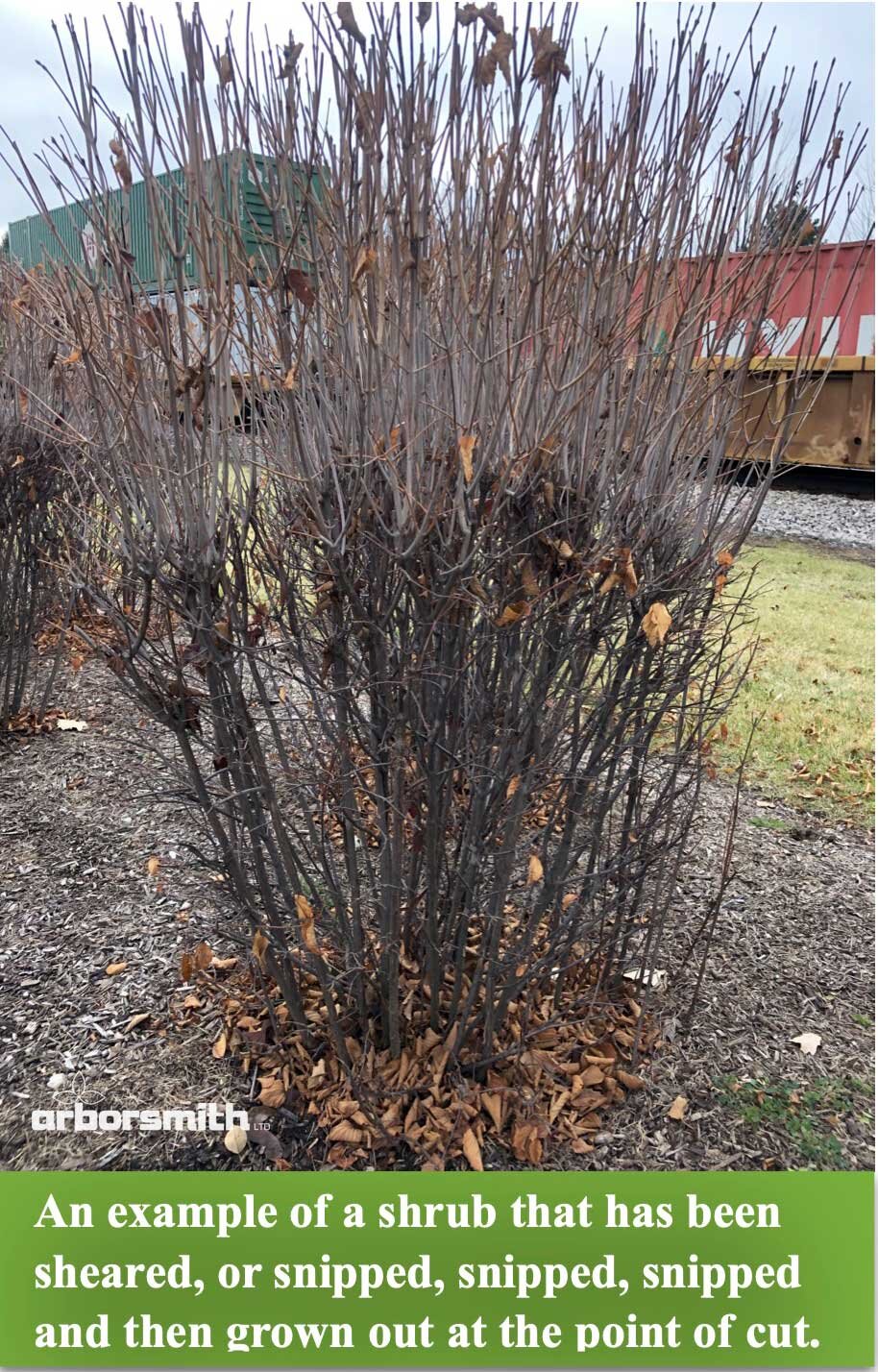My Lilacs Never Flower
/Backyard Wisdom - February/March 2021
by: Gilbert A Smith, ISA Board Certified Master Arborist
Photos by Lesley Bruce Smith
With snow on the landscape and temperatures in the cold range you're probably not thinking about trimming your deciduous (non-evergreen) shrubs. Still, now and until the leaves come back in May/June is a really great time to trim them. I’m going to give you easy to follow, step by step directions.
But first let me explain why.
If you read the horticulture books they will almost always instruct you to trim flowering shrubs only after flowering. They say this because about a month after flowering our wonderful Lilacs, Forsythias, Magnolias and other flowering woody plants (all trees and shrubs, both evergreen and deciduous) begin forming flower buds for next year. Why? Because it takes a lot of energy to make flower buds and the sun, where our plants get their energy, is strongest in the summer. If you trim your shrubs with hedge sheers in the fall or spring, as most people do (and I hope to convince you otherwise) you will be cutting off most of the flower buds. So what good is a shapely Lilac without flowers? It is not funny how many times our new clients tell us, “Oh, that Lilac never flowers.” Over and over we have to say, “Keep your landscaper away from shearing it and it will soon bloom beautifully!”
So, timing is the first misunderstanding and method is the second. Too many years ago at the University of Illinois, our Landscape Architecture professors held up hedge sheers and told us, “Throw these things away and never use them again!” and we all laughed, smugly. Fifty years later, hedge sheers are still the main shrub trimming implement and it remains by far, the most damaging treatment to our lovely flowering shrubs and trees.
Again, let me explain.
When we cut our woody plants, we stimulate growth at the point of cut. Let me say that in a different way for emphasis. If you cut your plants back to the size you want them to remain, you will actually be telling them to grow larger than you intend. You see, plants have ingenious growth regulating hormones to keep branches from A beautiful Lilac in its glory competing with one another. These smart hormones direct the branches to allow light penetration throughout the plant so each stem can be fed from its exposure to the sun. Also, the hormone direction allows air movement throughout the plant, keeping fungi and bacteria from attacking wet leaves. Pretty smart don't you think? However, when we cut the branches in an attempt to contain them we unbalance these hormone regulators and tell the plants to grow, grow, grow in every crazy direction. Just the opposite of what we intended. So remember, when we snip, snip, snip we’re telling the plant to grow, grow, grow!
So how do we keep our plants from getting too big? It is really pretty simple, all you have to do is to vary the depth of your cuts. The way you do that is to cut a few (5%) large branches to the ground. Remember to select the tallest branches so that you reduce the size. Next, cut a few (5%) branches in the middle of the plant, again concentrating on the tallest. Last, to neaten the contour of the plant, cut a few (5%) branches on the outside. It’s that simple, oh, except that you have to remember to cut back to an outward pointing branch so the branches don't run into each other. For some great pictures and diagrams see our shrub trimming abstract. What you should notice is that we are trimming only 15% of the plant so the flowering will not be interrupted and you can do it any time of the year. I prefer winter because the dormant plants respond well to trimming and without the foliage I can see the branches that I want to cut so much more easily.
Finally I want to talk about being a good plant owner. If you look throughout your neighborhood you will see a lot of round and cube-shaped plants. Most of us think that if our ornamental trees and shrubs are not perfectly round or cube-shaped that we are not good stewards of our landscapes. I don't know why. I think the devil made us do it. It is absolutely not true. Not true aesthetically, because our plants should soften and accent our hard architectural lines. Loose, flowing, flowering and graceful plants is what we all dream of, not…you know. And it is not good stewardship horticulturally either. Whacking your plants back with sheers every year is difficult to do and damaging to all of your plants. Does that make any sense? Shearing your shrubs and trees into balls and cubes is the worst thing you can do for their health.
Let me say just one final thing and then I’ll get off my soap box.
A good Landscape Architect will plant each plant where it will grow and flourish without a lot of sheering. If it is rubbing the house or getting into the driveway that is not the plant’s fault. Chopping plants back hurts them more than you can know, it hurts your pocket book or your back and it is completely unnecessary. It is not a part of a good landscape. When we can sit back, relax and appreciate each individual plant for its lovely architecture, the way it blows in the breeze and the way the flowers grace our neighborhood, that is being a good steward of our little corner of the world.
Mother Nature’s Moment • Getting to Know Your Trees - White Oak



